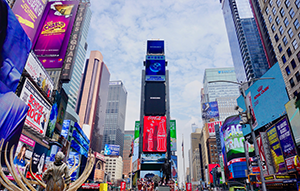
How Billboards Are Made
The billboard posting and design process is fairly extensive, and the evolution of this process is quite fascinating.
The process of making—or posting— a billboard ad begins with the buyer. The leading question of any outdoor advertising project is, “What is the buyer’s vision?” After spending a couple hundred or even thousands of dollars on billboard space, it’s important that the buyer is able to bring their ideal advertisement to life.
Billboard vendors often give their clients a good amount of creative freedom to design their own ads. If they do not have the time or necessary software to create digital designs, the billboard buyer can export the work to a graphic designer. To make things easier, here at BillboardsIn, we have an art department standing by for our clients’ needs. Through collaboration, the client’s original vision is transformed into an effective billboard ad.
Once the art is completed, it gets sent to the printer. It is here that it can be printed in a variety of ways. The most common is to print the design on a vinyl tarp. This is usually done by using a wide format printer with a print roll between 18 and 100 feet wide.
The vinyl that most billboards are made of is commonly sourced from a plastic compound called polyvinyl chloride (PVC). While this material isn’t easily recyclable, billboard vendors still find ways to repurpose old vinyl tarps. A more eco-friendly material is polyethylene (PE), which is more easily recycled. It’s also a lightweight material, so less energy is required to produce it.
If a design is to be printed, it needs to be created using the CMYK color mode on the art software that is being used. For digital billboards, you would use the RGB color mode. This type of board uses several million dots to make up a larger image on a digital screen. These individual dots consists of red, green, and blue.
Before the rise of digital art and printers, advertisers would have to rely on the refined skills of “traditional artists” who would hand paint wall murals and signs. In addition to being costly, this method of billboard creation took a considerable amount of time—typically days to weeks. The contemporary method of printing on vinyl is a significantly more efficient process. In fact, the installation of a vinyl billboard can actually be done in under 20 minutes with a two-man team.
Wall murals are no longer the industry norm, but it’s by no means a dead art form. Colossal Media is a company dedicated to painting beautiful and eye-catching wallscapes for advertisers. Their work is located in major cities across the United States, including New York, Los Angeles, and Chicago.
Billboard creation has evolved over the years to become more convenient, so to look back at its origins is quite fascinating. The first example of billboards as a concept can be traced back all the way to ancient Egypt, around 1000 B.C. The Egyptians would chisel messages onto stone walls that were located in areas that experienced lots of foot traffic, which made it an effective form of mass communication.

